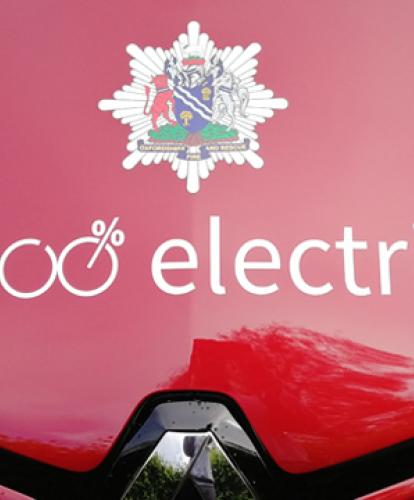The drive to reduce carbon emissions and clean up the air has stepped up a gear as Oxfordshire County Council takes delivery of a new fleet of electric cars and vans.
As the largest council in Oxfordshire, the county council has already taken a strong lead and committed to being carbon neutral by 2030. Achieving that aim will benefit the county’s thriving communities and mean radically changing the way some things are done.
Along with the commitment to being carbon neutral the county council has also signalled its dedication through high-profile sustainable energy projects like Local Energy Oxfordshire, the V2GO charging initiative as well as seeking to reduce the number of miles its staff travel for things like meetings by encouraging flexible working and greater use of virtual meeting technology.
Moving to an electric-powered fleet of vehicles is seen as a key step and the Fire and Rescue Service is positively charged about its new Renault Zoe and Kangoo vans – all of which produce no exhaust emissions and are cheaper to run.
Because of this the new fleet, which is the first part of a strategy that will see the council replacing as much of its vehicles fleet with zero exhaust emission alternatives as possible, is already starting to make a contribution to improving air quality.
The vehicles can travel up to 160 miles on a single charge and will be used by Fire Safety Officers, as pool cars and as fire station vans and can be charged at any of the fire stations.
The county council is in the process of replacing its general pool cars with rechargeable models, with three already in use.
Grahame Mitchell, Assistant Chief Fire Officer, explained: “Transport can make a major contribution to air quality and the environment. Making positive changes like switching to electric vehicles is just one way in which key pollutants can be banished from our roads and communities.
“The performance of electric vehicles has come on immensely in recent years and the ones that we have chosen meet our needs very well. They will be put through their paces by our staff and their experiences will help us when we replace more of our fleet.
“Although the initial costs of electric vehicles are higher than conventional vehicles the much lower servicing and running costs soon re-coupe this difference and providing the council with both a clean and cost effective transport.”
Zero-emission plan for transport in Oxford
Oxfordshire County Council jointly with Oxford City Council published updated proposals for a Zero Emission Zone (ZEZ) in Oxford centre, setting a journey to zero transport emissions in the city by 2035.
From 2020 onwards, a ZEZ with apply to some vehicles and journey types, with restrictions increased gradually to all vehicles in the following years to create a largely transport emissions-free city centre. The aim of the ZEZ is to tackle Oxford’s toxic air pollution and protect the health of everyone who lives in, works in and visits the city.
It is also expected that the ZEZ will improve air pollution levels across Oxfordshire because the buses and taxis that serve Oxford also serve towns and villages across the county.



